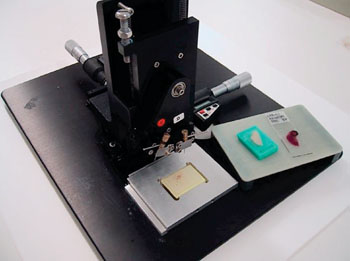SIP1 Protein Expression Indicates Poor Prognosis in Pharyngeal Cancer
By LabMedica International staff writers
Posted on 02 Dec 2014
The expression of the Smad interacting protein 1 (SIP1) in pharyngeal squamous cell carcinoma tumors often indicates an advanced tumor stage, a high risk of recurrence and a poor prognosis.Posted on 02 Dec 2014
Although pharyngeal squamous cell carcinoma (PSCC) is a rather rare disease, its incidence has been increasing over the past three decades, now accounting for 130,000 new cases and 80,000 cancer deaths worldwide and the prognosis is one of the poorest of all the head and neck squamous cell carcinomas.

Image: A tissue micro arraying instrument (Photo courtesy of Beecher Instruments).
A scientist at the University of Eastern Finland assessed the role of Epithelial-mesenchymal transition (EMT)-related transcription factors in PSCC. The immunohistochemical expressions of transcription factors SNAI1, TWIST, SIP1, SLUG and ZEB1 were analyzed in tumor cells, stromal and endothelial cell nuclei, as well as in cytoplasm of PSCC samples in an effort to evaluate the association of their expressions with clinicopathological variables and patient prognosis.
Sufficient material for tissue microarrays and immunohistochemical analyses were available from 110 original tumor samples for SNAI1 staining, 109 for TWIST staining and 108 for SIP1, ZEB1 and SLUG staining. The two most representative areas of the paraffin-embedded tissue blocks were chosen by an experienced pathologist and marked for microarrays which were constructed using 1.0 mm core Manual tissue arrayer I (Beecher Instruments, Silver Spring, MD, USA).
The tumors with positive epithelial nucleal SIP1 immunostaining were more advanced and had more lymph node metastases. The expression of SIP1 was also linked to poorer disease-specific five-year survival and was an independent prognostic factor in multivariate analysis together with tumor size and general patient status. SNAI1 expression in endothelial cells predicted reduced survival and increased tumor size, whereas TWIST expression in stromal cells was linked to higher risk of recurrence.
The co-expression of SNAI1, TWIST, and SIP1 in tumor epithelial cell nuclei predicted poorer prognosis than SIP1 expression alone. The author, Dr. Anna Jouppila-Matto, MD, PhD, presented the results in her doctoral thesis and concluded that SIP1 is a potential new prognostic factor for clinical use, helping to single out patients with more aggressive tumor behavior requiring more intensive therapy and closer follow-up.
Related Links:
University of Eastern Finland
Beecher Instruments














